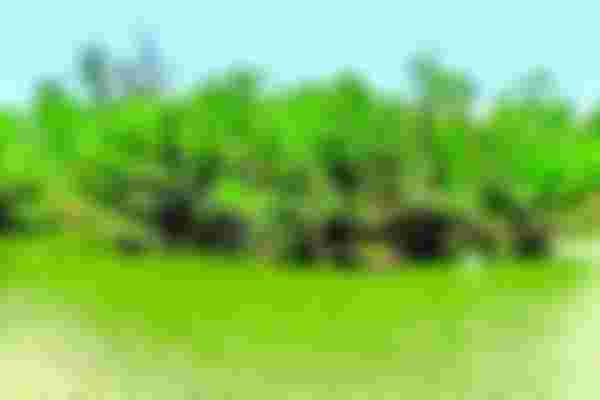
The Sundarbans is the largest mangrove forest in the world, located in the delta region of the Ganges and Brahmaputra in the southern part of Bangladesh. The forest is located between 21 ° 306-22 ° 308 north latitude and 89 ´ 008-69 ° 558 east longitude, which extends along the coast of India and Bangladesh, just south of Tropic of Cancer. The exquisite variety of plants and the unique combination of wildlife has made this forest a unique natural feature. It is also considered a significant center of economic activity; Forest trees suitable for various purposes are collected from here, and a large quantity of honey, beeswax and fish are extracted. The Sundarbans of Bangladesh extends over parts of Satkhira, Khulna and Bagerhat districts. There are about 400 interconnected rivers, canals and about 200 small and large islands scattered in the Sundarbans.

About 200 years ago, the area of the main Sundarbans was about 16,600 sq km. It has now shrunk to one-third of its actual size. After the partition of British India, two-thirds of the forest fell in Bangladesh and the rest in India. The present area of this forest will be about 4,110 sq km, of which about 1,600 sq km is wetlands. The entire Sundarbans consists of two forest divisions. There are four administrative ranges - Burigoalini, Khulna, Chandpai and Sharankhola; And 16 forest stations. To facilitate management, the Sundarbans has been divided into nine blocks and 55 compartments. In 1855, the Sundarbans was declared a protected forest. About 32,400 hectares of this forest area has been identified as a wildlife sanctuary and has been a UNESCO World Heritage Site since 1999. The sanctuaries of the Sundarbans were established in 1987 in accordance with the Bangladesh Wildlife (Conservation) Order (Amendment), 184.
The three areas covered are: Sundarbans West (9,089 ha), Sundarbans South (18,6 ha) and Sundarbans East (5,439 ha).
The name ‘Sundarbans’ is probably due to the abundance of beautiful trees (Sundari-forest) or the forest of the sea (sea-forest) or the indigenous Chandraveda of this forest. The general interpretation is that the forest is named after the main plant, the beautiful tree (Heritiera fomes).

ভূতত্ত্ব উৎপত্তির দিক থেকে সুন্দরবনের ভূভাগ সাম্প্রতিককালের এবং হিমালয় পর্বতের ভূমিক্ষয়জনিত জমা পলি থেকে এর সৃষ্টি। ভূগঠন প্রক্রিয়াটি সাগরের জোয়ারের কারণে ত্বরান্বিত হয়েছে। এর নিম্নস্তর প্রধানত কোয়াটারনারি যুগের (Quaternary) তলানিতে গঠিত, যার সংমিশ্রণ ঘটেছে বালি, পলি, সামুদ্রিক লবণ এবং কাদামাটির সঙ্গে। ভূতত্ত্ববিদগণ এখানকার ভূগঠনবিন্যাসে দক্ষিণ-পূর্ব দিকে সামান্য ঢালের সন্ধান পেয়েছেন এবং সেসঙ্গে টারসিয়ারি সময়ে সংঘটিত বাংলার অববাহিকার (Bengal Basin) ঝুকানো অবস্থা শনাক্ত করেছেন। দশম থেকে দ্বাদশ শতাব্দীতে সংঘটিত নব্য-ভূগঠনিক আন্দোলনের ফলশ্রুতিতে বেঙ্গল বেসিন পূর্বমুখে ঝুঁকে পড়ে। সন্ধানমূলক কূপ খনন (borehole) গবেষণা থেকে প্রতীয়মান হয় যে সুন্দরবনের পশ্চিম এলাকা অপেক্ষাকৃত সুস্থিত হলেও দক্ষিণ-পূর্ব কোণার অংশ একটি সক্রিয় পলিজ এলাকা এবং ক্রমে তা নিচের দিকে নেমে যাচ্ছে।

Soils Compared to other soils in the interior of Bangladesh, the soils of the Sundarbans mangrove forest are different and the effects of waterlogging and salinity are evident due to the tides in these forests. Due to such unique features of the soil, the flora here is also characteristic. In some parts of this tidal forest, the soil is semi-solid and not very strong; The range of pH values is wide, from 5.3 to 6.0. Although the soil of the Sundarbans is of medium texture and sandy loam, alluvial loam or muddy loam nature, there is considerable difference in the size and extent of soil grains. Sedimentary loam is the main constituent of the soil here.
Sodium and calcium levels are 5.6 to 29.6 meq per 100 g of dry soil and are generally lower in the eastern part of the forest and gradually higher in the west. Potassium content is relatively low, 0.3 to 1.3 meq per 100 g of dry soil. The level of organic matter in the dry soil is 4 to 10 percent. Soil salinity is slightly moderate in the eastern region, but gradually increasing is significantly higher in the western region. There is no consistency between the salinity of the land from north to south in the whole forest.
Climate As the Sundarbans is located south of the Tropic of Cancer and extends along the northern boundary of the Bay of Bengal, the forest is classified as a tropical moist forest. The temperature of the Sundarbans is fairly balanced as compared to the forest lands. The average annual maximum and minimum temperatures in different parts of the country range from 31 ° C to 21 ° C. Temperatures are highest from mid-March to mid-June and lowest in December and January. In the Patuakhali area east of the Sundarbans, temperatures reach 32.4 ° C during the warmer months.

Sodium and calcium levels are 5.6 to 29.6 meq per 100 g of dry soil and are generally lower in the eastern part of the forest and gradually higher in the west. Potassium content is relatively low, 0.3 to 1.3 meq per 100 g of dry soil. The level of organic matter in the dry soil is 4 to 10 percent. Soil salinity is slightly moderate in the eastern region, but gradually increasing is significantly higher in the western region. There is no consistency between the salinity of the land from north to south in the whole forest.
Climate As the Sundarbans is located south of the Tropic of Cancer and extends along the northern boundary of the Bay of Bengal, the forest is classified as a tropical moist forest. The temperature of the Sundarbans is fairly balanced as compared to the forest lands. The average annual maximum and minimum temperatures in different parts of the country range from 31 ° C to 21 ° C. Temperatures are highest from mid-March to mid-June and lowest in December and January. In the Patuakhali area east of the Sundarbans, temperatures reach 32.4 ° C during the warmer months.

Average annual relative humidity fluctuates between 60% in Satkhira and 40% in Patuakhali. Relative humidity is highest in June to October and lowest in February. Annual rainfall in the Sundarbans 1840-2000 mm; Rainfall is relatively high from west to east of the forest. Most rainfall occurs during the monsoon season, between May and September. There is sometimes heavy rainfall between mid-June and mid-September. Storms and tidal surges often cover large areas of forest and cause extensive damage to plants and animals.
Vegetation Most of the vegetation in the Sundarbans is mangrove and has a wide variety of vegetation including trees, shrubs, grasses, parasites and climbing plants. Most are evergreen, so their physiological and anatomical adaptations are more or less the same. Most trees have pneumatophores, which allow them to take in oxygen directly from the air for respiration. The main tree species of this forest are Sundari and Gewa (Excoecaria agallocha). In 1903 d. In his book on the vegetation of the Sundarbans, Praine lists 334 plant species under 245 genera; Of these, 16 are pteridophytes, 7 are monocotyledons and the remaining 230 are dicotyledons. The species includes 35 legumes, 29 herbaceous plants, 19 hogla species and 16 euphorbias. Of the approximately 50 actual mangrove plant species known to date, only 35 are found in the Sundarbans. Most mangrove plants are evergreen, short, shrubby or tall arboreal. Many of them usually grow in groups without leaving the bottom of the forest empty
E. agallocha, Ceriops decandra, Sonneratia apetala, S. caseolaris, S. caseolaris, Xylocarpus mekongensis, X. granatum, Bine (Av. alba, A. marina, A officinales) and other herbaceous plants. Hendaleo (Phoenix pelludosa) is one of the major plant species in the area. In the middle of the forest, the characteristic tree species of the mangrove forest is predominant. Most of the southern part of Khulna and Bagerhat districts are covered with moderate salt water forests, and the main plant species is beautiful.
Nipa fruticans grow densely on the banks of almost all canals. The abundant freshwater flowing through the Pashur, Haringhata and Burishwar rivers has helped in reducing the salinity and creating tolerable freshwater forest areas in the surrounding areas.
In the Sundarbans, some vegetation stages are evident, with some pioneering species in newly formed lands, such as Arali (Leersia hexandra) and wild rice (Potresia sp), followed by Bain (Avicennia), Keora (Sonneratia) and Khulshi (Aegiceras). The second plant stage includes Ceriops, Excoecaria, Bruguiera, Heritiera, Xylocarpus, and Rhizophora. Tiger fern (Acrosticum aureum) grows in saline and low salinity areas. Tigers use these bushes to cover their bodies.
Animals Various types of animals live in the Sundarbans. This is the most important habitat of the Royal Bengal Tiger (Panthera tigris). In addition, the forest has about 50 species of mammals, 320 species of resident and migratory birds, about 50 species of reptiles, 6 species of amphibians and about 400 species of fish.
Notable mammals in the Sundarbans besides the Royal Bengal Tiger include the Chitra deer (Cervus axis), Maya deer (Muntiacus muntjak), Rhesus monkey (Macaca mulatta), wild cat (Felis chaus), leopard (Prionailurus), hedgehog (Hystrix). (Lutra perspicillata) and wild boar (Sus scrofa). Deer and wild boar are the main prey of tigers. Some other species including tigers are endangered hereEcological diversity has given the Sundarbans a unique habitat for a variety of birds. Most of the birds that live here are native or resident, about 50 species are non-resident or migratory and most of them are ducks. Numerous coastal birds, including storks, storks, hargilas, mud-stingers, lentils and hawthorns, roam the riversides. Many species of gannets, water pigeons, terns, etc. are found on the shores of the sea and large rivers. There are about 22 species of eagles, eagles, vultures, etc. of the genus Accipitridae.
There are 9 species of fish in this forest. Excellence in Bird Resources In the Sundarbans, there are various types of small singing birds including woodpecker, bhagirath, owl, honey bee, bulbul, shalik, finge, babui, pigeon, bene bau, hamrichancha, fuljhuri, munia, tuntuni and doyel.
The largest member of the Sundarbans is the estuary crocodile (Estuarine crocodile, Crocodylus porosus) of about 50 species of reptiles; Some of them are about 6 meters long. At one time they were seen in large numbers in the mangrove environment, but now it is estimated that there will be only 250 of them. Representations of lizards, tortoises and snakes, including guaisap (Varanus spp), are satisfactory. Notable snakes include King cobra, Ophiophagus hannah, Russell's viper (Vipera russellii), python (Python molurus), banded crate (Bungarus fasciatus) and several species of sea snakes.Only 6 species of amphibians have been described from the Sundarbans. Green frogs (Euphlyctis hexadactylus) are more common in Chandpai area. Other amphibians in this forest area include skipper frog (E. cyanophlyctis), cricket frog (Limnonectes limnocaris), tree frog (Polypedates maculatus) and common kuno frog.
About 400 species of fish live in the rivers and other reservoirs of the Sundarbans; On the one hand, there are fish that move in different levels of water, on the other hand, there are some fish species that live under the water. Many fish use mangrove reservoirs as their breeding grounds. Fish farms or fish farming are not allowed in the Sundarbans. The fishing activities in the whole area are controlled by the forest department.
Among the invertebrates, some mollusks and crustaceans are considered important fisheries. Among the economically important species listed are about 20 species of shrimp, 6 species of lobsters, 6 species of crabs, a few species of snails and 8 species of oysters. Among the shrimps, commercially important are shrimp (Penaeus monodon) and deer shrimp (Metapenaeus monoceros) and mud crab (Mud crab, Scylla serrata). The diversity of insects in the Sundarbans is limitless. The economically important species here is Apis dorsata. The occupation of the locally known ‘Mouyals’ is to collect honey. They collect honey from the forest for three to four months during the flowering season with the permission of the forest department. There is an abundance of spiders (Araneae) in the Sundarbans. From here, about 300 species of spiders have been listed under 22 genera.The most significant importance of the Sundarbans in terms of economic value, tourism and population is its conservation role. These forests prevent coastal erosion, restore coastal areas, and stratify riverine sediments. Its estuary is a breeding ground for many types of fish. A number of industries have sprung up around the forest resources of the Sundarbans. These include Khulna Newsprint Mills and Hardboard Mills; The raw material of the first is Gewa and the beautiful tree of the second. Other plant-based industries include matches and boat-making factories. This forest is one of the main sources and suppliers of fuel, tannins, tent-making materials, wood products, medicinal plants and animal feed. Most of the country's honey and beeswax are collected from the Sundarbans. There are many important honey plant species like Aegiceras corniculatum, Ceriops decandra, Nipa spp, Derris spp and Hibiscus tiliaceus.
The Sundarbans is an attractive place for tourists for leisure travel. Katka, Hiran Point (commonly known as Nilkamal), Dublar Char and Tiger Point (Kachikhali) attract a large number of tourists every year. Cuttack has impeccable scenery and is extremely attractive to wildlife travelers. There is a post bungalow run by the forest department and an observation tower. Diamond Point also has a guest house for tourists and an observation tower. Dublar Char is a small island, with beautiful beaches. Another attraction is the fishing activity, which runs from mid-October to mid-February each year. Hundreds of fishermen came from different parts of the country, especially from Chittagong. Here they catch fish and dry it on sunny beaches. Honey beekeepers usually go deep into the forest in April-May to look for bees.
Very few people live permanently in the Sundarbans or adjoining areas of the Sundarbans. Permanent residents include Bawali (those who collect golpata), Mual and Kathure. They build a wooden or bamboo platform at a height of 3-5 meters near the edge of the forest and build houses on it. Some people, especially Bedera, lead a nomadic life in boats. [Mostafa Kamal Pasha and Niaz Ahmad Siddiqui]
Reproduction of Sundarbans Forests are regenerated by natural processes or by sowing seeds or planting saplings. Mangrove plants in the Sundarbans are largely dependent on the process of natural reproduction. In most areas of the forest, a lot of seeds are collected for transplanting. It has been observed that an average of 28,750 saplings are produced per hectare per year, though its density varies from forest to forest. Sundari, Gewa and other tree species together produce about 24, 54 and 22 per cent saplings (three months old) respectively.
The salinity of the forest area actually affects the reproduction density, the more salinity the density decreases. The amount of seedlings supplied varies from year to year, but the effect of salinity is negligible. Variations in the level of sapling production are noticeable in the three saline areas of the Sundarbans. The production of seedlings of Sundari, Gewa and other tree species varies from year to year. This difference is probably due to the periodicity that exists in plant species.




The Sundarbans is the largest mangrove forest in the world, located in the delta region of the Ganges and Brahmaputra in the southern part of Bangladesh. The forest is located between 21 ° 306-22 ° 308 north latitude and 89 ´ 008-69 ° 558 east longitude, which extends along the coast of India and Bangladesh, just south of Tropic of Cancer. The exquisite variety of plants and the unique combination of wildlife has made this forest a unique natural feature.
Wow this nice information Thanks dear.........